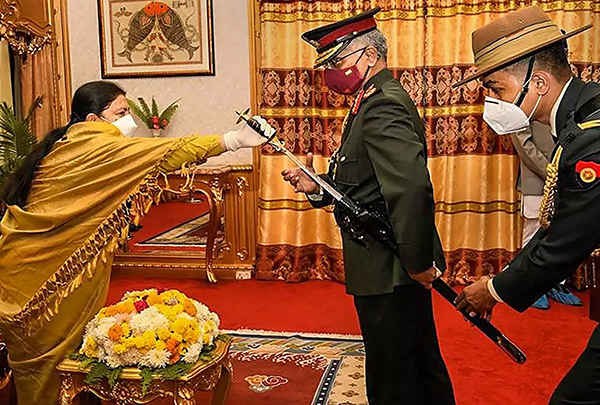

Army Chief Gen MM Naravane, paid a three-day visit to Nepal, from 4 November. During his visit he met prime minister of Nepal KP Sharma Oli, his counterpart Gen Purna Chandra Thapa, Chief of the Nepal Army. He was conferred the honorary rank of General of the Nepal Army by the President of Nepal, Vidya Devi Bhandari.
The Army Chief paid homage and laid a wreath at the Bir Smarak. He also handed over medical equipment, including ventilators, and interacted with trainee officers at the Command and Staff College of Nepalese Army in Shivapuri.
Lipulekh Dispute
Bilateral ties between India and Nepal were hit in May after Nepal claimed the Lipulekh region in north-eastern edge of Uttarakhand. Lipulekh is a tri-junction between India, Nepal and China. The Nepalese claim was made after defence minister Rajnath Singh inaugurated an 80-km-long strategically crucial road connecting the Lipulekh pass with Dharchula in Uttarakhand on May 8. It reduces the travel time to Kailash Mansarovar pilgrimage by several km.
ALSO READ: Nepal Has Violated The Treaty of Sugauli, 1816
Nepal said the road was constructed in its territory but New Delhi all along maintained it was well within its boundary and some kilometers away from the Line of Actual Control (LAC) with China there. Kathmandu responded by issuing a new map that showed Kalapani, Lipulekh and Limpiyadhura, all controlled by India, as part of Nepalese territory, exacerbating the row. It questioned the treaty of Sugauli signed in 1815 after the Anglo-Gurkha war.
New Delhi had paused talks with the Himalayan nation’s communist government after its parliament cleared a new map in June 2020 featuring areas which India maintains belong to it. In its reaction after Nepal’s lower house of parliament approved the bill, India termed as untenable the “artificial enlargement” of territorial claims by the neighbouring country.
After Nepal released the map, India reacted sharply, calling it a “unilateral act” and cautioning Kathmandu that such “artificial enlargement” of territorial claims will not be acceptable to it. India said Nepal’s action violates an understanding reached between the two countries to resolve the boundary issues through talks.
In September, prime minister Oli decided to stop distribution of next school textbooks that had been published with the country’s revised political map. India too had published a new map in November 2019 showing the areas as its territories.
The Lipulekh pass is a far western point near Kalapani, a disputed border area between Nepal and India. Both India and Nepal claim Kalapani as an integral part of their territory – India as part of Uttarakhand’s Pithoragarh district and Nepal as part of Dharchula district.
In the midst of the row, Gen Naravane said that there were reasons to believe that Nepal objected to the road at the behest of “someone else”, in an apparent reference to a possible role by China in the matter. The comments triggered angry reactions from Nepal. Taking exception to these comments by the Army Chief, Nepalese defence minister Ishwar Pokhrel had said they “hurt the sentiments of the Nepali Gurkha army personnel who lay down their lives to protect India.”
Meeting With Prime Minister
Gen Naravane’s meeting with KP Sharma Oli, who also holds the defence portfolio focused on defence-related issues. The development assumed significance in the wake of the fact that Naravane was the first high-ranking official to visit Nepal a year after the boundary dispute erupted between the two countries.
The Army chief’s visit saw the two countries further ramping up the ties and explore ways to have more interactions including joint training and exchange of personnel for study visits to institutes in each other’s country.
India and Nepal have time-tested strong defence and security ties, with regular exchanges and training programmes.
India’s strategic military relations with Nepal are at two levels – between the two sovereign armies and the Indian Army’s Gorkha connect. Nearly 30,000 Gurkhas serve in seven regiments of the Indian Army. Politicians with Leftist leanings, especially Maoists in Nepal, have invariably raised the question of stopping recruitment in foreign armies, especially the Indian Army.
In 1965, King Mahendra, and in 1990, King Birendra requested India to modernise the Nepal Army, which is equipped 80 per cent with Indian military hardware provided at friendship prices – 70 per cent aid and 30 per cent payment, which over time has become near gratis. According to treaty arrangements, Nepal acquires military equipment from abroad only when India is unable to provide them. But this is not sacrosanct as the US, the UK and east Europe have provisioned the Army.
Nepal Army’s specialised training is held in India and it has a number of training slots. Joint training has reached the battalion level under the Surya Kiran series and military exercises are held in both the countries.
Economic Relations
Land-locked Nepal relies heavily on India for the transportation of goods and services. Nepal’s access to the sea is through India, and it imports a predominant proportion of its requirements from and through India.
Nepal’s imports from India in 2017 were worth $6.52 billion while its exports to the country were pegged at $420.18 million. The figure for China, which was second on the list of countries from which Nepal imported its requirements, was five times lower than that of India.
ALSO READ: China-Nepal Rail Link Planned
In August, the two sides held a meeting of their oversight mechanism that oversees India-funded development projects and agreed to speed up work on bilateral projects, including infrastructure schemes and cross-border rail links. It was the first step by the two countries to mend their relations and get down to business.
In the coming days both sides may hold talks to speed up the Pancheshwar multi-purpose project on river Mahakali and other hydro-electric projects with India. Also, India may also work closely with Nepal in the fields of education, health and infrastructure development sectors in Nepal.
Comments
India’s decision to send the Army Chief to Nepal to reset the ties is seen as part of a larger exercise by New Delhi to rejuvenate relations with Myanmar, the Maldives, Bangladesh, Sri Lanka, Bhutan and Afghanistan in the wake of greater efforts by China to expand its influence in the region.
Gen Naravane’s three-day visit to Nepal was expected to have a significant diplomatic overtone with India looking at resetting relations with the Himalayan nation after the ties came under severe strain following a bitter border row.
It was the first high-level visit from India to Kathmandu since Nepal came up with a new political map in May claiming several areas in Uttarakhand to be part of its territory.
Earlier in October, Gen Naravane had travelled to Myanmar along with foreign secretary Harsh Vardhan Shringla on a very crucial visit during which India decided to supply an attack submarine to the Myanmarese Navy besides agreeing to further deepen military and defence ties.
Nepal is important for India in the context of its overall strategic interests in the region, and leaders of the two countries have often noted the age-old ‘Roti-Beti’ relationship.
Nepal is geo-strategically the most important neighbour. In 1959, the then prime minister Jawaharlal Nehru had said that an attack on Nepal and Bhutan will be deemed as an attack on India.
India’s strategic thinkers are concerned over reports of China grabbing Nepalese territories in a number of locations along the borders between the two countries, though Kathmandu had clarified recently that there were no such encroachments.
During crisis or calamity in Nepal, the Indian military has become the first responder – for example, aviation tragedy at the Tribhuvan International Airport 1990s, the earthquake in 2015, after the earthquake.
=============
China Has Annexed Over 150 Hectares in Nepal
China has annexed over 150 hectares of Nepal’s territory, according to a leading British daily whose report was rejected by the Chinese Foreign Ministry on Tuesday as a “completely unfounded rumour”.
Spokesman for the Foreign Ministry Wang Wenbin’s remarks came after The Telegraph quoting Nepalese politicians reported that China has annexed more than 150 hectares of land in five areas near the border, including by diverting the flow of a river to reclaim the previously submerged land.
“According to reports, Beijing is fast moving forward and further pushing Nepali boundaries by encroaching more and more landmass. The actual scenario could be worse as the ruling Nepali Communist Party (NCP) is trying to shield the expansionist agenda of the Chinese Communist Party (CCP),” said an expert on the condition of anonymity.
The Chinese influence in Nepal has grown dramatically since the Communist Government is in place.
















